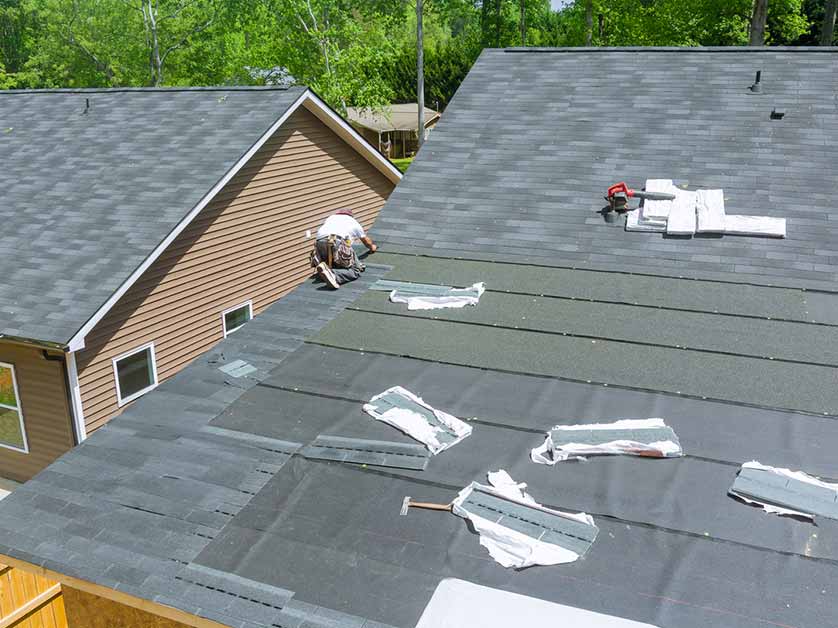Underlayment is a crucial, often unseen component of a roofing system that provides additional protection beneath the shingles. While shingles are the primary defense against weather elements, underlayment reinforces this protection, offering an extra safeguard against moisture, wind, and temperature fluctuations. We will explore how underlayment with the help of a roofing contractor contributes to a roof replacement’s durability, functionality, and overall quality, highlighting its role in extending the roof’s life and enhancing home comfort.
Ways underlayment contributes to a roof replacement’s durability
- Enhancing Moisture Protection
One of the primary functions of underlayment is to provide a moisture-resistant barrier between the shingles and the roof deck. Roofs are exposed to weather conditions, including rain, snow, and ice. Although shingles are designed to repel water, they are not entirely waterproof. Water can seep beneath the shingles during heavy rain or snowmelt, potentially leading to rot, mold growth, and structural damage if it reaches the roof deck.
Underlayment, typically made from felt or synthetic materials, is an extra layer that traps and redirects moisture before it can reach the decking. This added protection is especially valuable in areas with heavy precipitation or fluctuating temperatures that cause ice dams. By preventing water from infiltrating the roof structure, underlayment safeguards the home against leaks, structural damage, and costly repairs, contributing to a longer-lasting, more resilient roof.
- Increasing Wind Resistance
In regions prone to high winds or hurricanes, the role of underlayment in wind resistance becomes particularly significant. Strong winds can lift shingles, allowing water to penetrate the roofing system. Underlayment provides a secondary barrier that helps keep water out, even if the shingles are compromised during high winds. Some synthetic underlayments are designed specifically for wind resistance, with materials that adhere securely to the roof deck, minimizing the risk of uplift.
This underlayment layer also helps maintain the roof’s integrity if shingles are lost or damaged in a storm. A single missing shingle could expose the roof deck to water damage. Underlayment enhances the roof’s resistance to wind-driven rain, ensuring the home remains protected against the elements even in challenging weather conditions. By reinforcing the roof’s defenses, underlayment provides peace of mind to homeowners, particularly those in areas susceptible to extreme weather.
- Improving Thermal Insulation
Thermal performance is another benefit of underlayment, as it contributes to the home’s insulation. Although underlayment is not as thick as attic insulation, it provides an additional layer that can help regulate temperature, preventing heat loss in winter and excessive heat gain in summer. This added insulation helps to keep the indoor environment more comfortable, reducing the workload on heating and cooling systems and lowering energy bills.
The material used for underlayment can also impact thermal efficiency. For instance, synthetic underlayments with reflective properties can further reduce heat absorption, which is particularly beneficial in warm climates. This temperature regulation reduces energy consumption, saving homeowners money while contributing to a more sustainable home. Underlayment, therefore, plays a role in protecting the roof from the outside and helping maintain a balanced, energy-efficient environment inside the home.
- Adding Fire Resistance to the Roofing System
Fire resistance is vital for homeowners, particularly those living in areas prone to wildfires. Certain types of underlayment, especially those made from synthetic materials, offer an additional layer of fire resistance, slowing the spread of flames and providing crucial time for emergency response. Fire-resistant underlayment is designed to withstand high temperatures, reducing the likelihood of fire spreading through the roof.
Using fire-resistant materials for underlayment is an important safety measure, particularly in roofing systems with combustible materials. When combined with fire-resistant shingles, this underlayment can enhance the overall fire safety of the home. While no roof is entirely fireproof, the added layer of underlayment offers an extra precaution that could make a difference in an emergency, protecting the home and its occupants from potential fire damage.
- Ensuring a Smoother Installation Process
Underlayment also plays a practical role in installing a new roof. It provides a smooth, even surface for shingles to be laid upon, which is especially important if the roof deck has any imperfections. By covering minor irregularities, underlayment allows for a more uniform appearance and better shingle adhesion. This base layer contributes to the structural stability of the entire roofing system, as shingles adhere better to an even surface.
Moreover, underlayment can prevent abrasion between shingles and the roof deck, reducing wear over time. This extends the lifespan of the shingles, as they are less likely to suffer damage from direct contact with the deck. A smooth underlayment installation helps ensure that the roof looks and performs well over time, supporting a quality installation that adds to the durability of the roof as a whole.
- Prolonging Roof Lifespan
A quality underlayment is an additional protective layer that prolongs the roof’s lifespan. By shielding the roof deck from moisture, wind, fire, and temperature extremes, underlayment mitigates many factors contributing to premature roof deterioration. This durability is especially beneficial for homeowners looking to maximize the return on investment from a roof replacement, as it reduces the need for frequent repairs and maintenance.
With the right underlayment, homeowners can expect their roofs to last longer, providing reliable protection for years. The long-term savings associated with a more durable roof are significant, as fewer repairs and less maintenance translate into cost savings. By investing in quality underlayment as part of a roof replacement, homeowners make a choice that contributes to the longevity of their roof and overall property value.
Underlayment is essential in a quality roof replacement by enhancing moisture protection, wind resistance, thermal insulation, fire resistance, and installation quality. This often-overlooked layer provides a foundation of durability and protection that keeps the roof functional and resilient. With the added benefits of energy efficiency and prolonged roof lifespan, underlayment is a valuable component of a roofing system that homeowners should prioritize. Through careful selection and installation of underlayment, homeowners can ensure a strong, lasting roof that meets the demands of weather and time.
